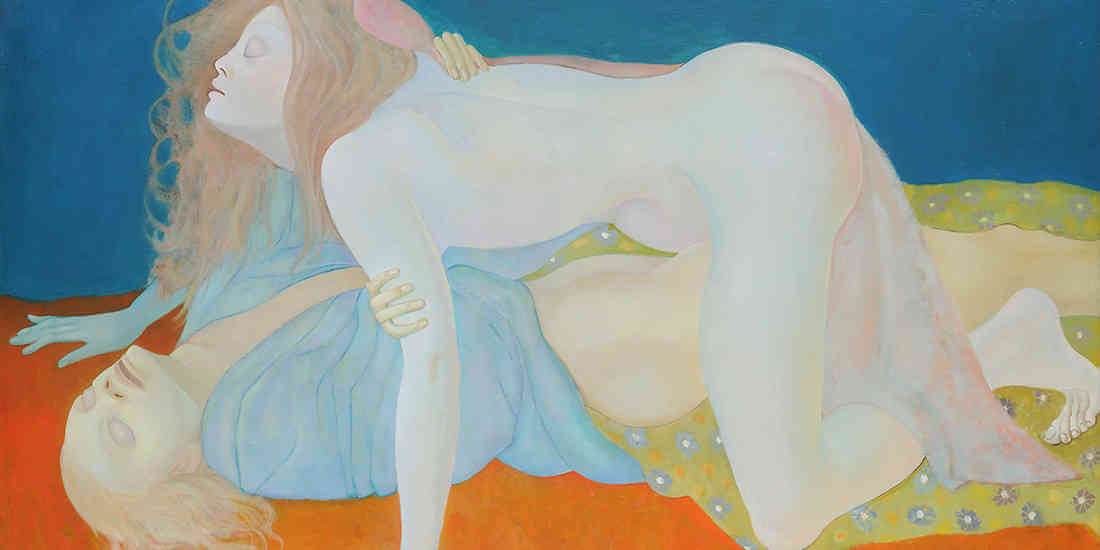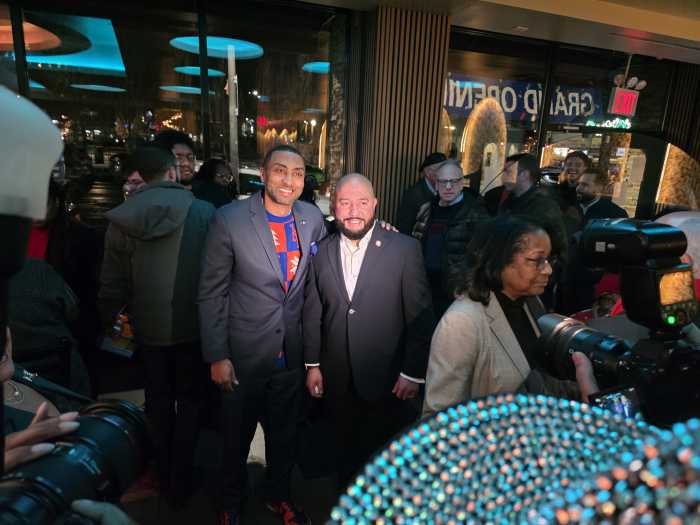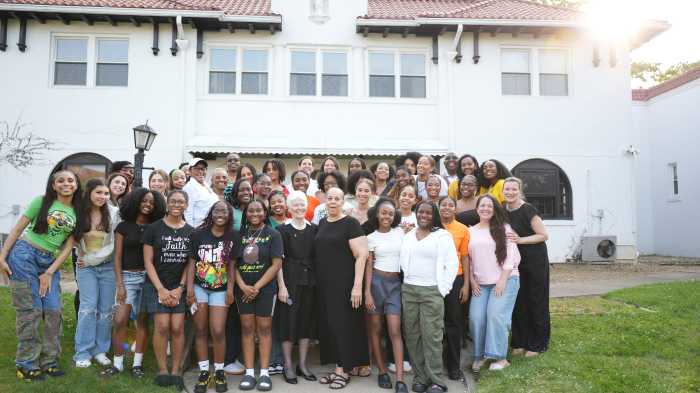If and when I die, I would love to be resurrected in a world created by Leonor Fini — a realm where it is the female who is all powerful, holding complete yet salubrious sway over all men, being more nurturing, empathetic, infinitely sagacious, and rather more beauty-loving than the true weaker sex. And, being male, I would not resent or resist this in the slightest, for the ideal Fini man, perforce, is a natural androgyne, fully in touch with the feminine and in total, deep sympatico with his beneficent dominators. Fini Paradise, populated by mythic creatures both human and otherwise, at times even morphing into each other, is a completely organic, profoundly fanciful universe of the utmost refinement and beauty, with all imaginable genders and sensual possibilities not only welcomed but celebrated.
All of these themes permeate the treasurable show “Leonor Fini: The Theater of Desire,” piquantly housed on two floors of the Museum of Sex, running through March 4. It is, unbelievably, the very first American retrospective of an artist who lived from 1907 to 1996 and whose name, although largely forgotten today, like her contemporary Miguel Covarrubias, who has a concurrent show now in Manhattan, was one to contend with in her heyday. She is finally glorified on Fifth Avenue with this selection of rare paintings, drawings, artist books, films, costume designs, never publicly viewed photographs, and ephemera from the Leonor Fini Archive in Paris.
Born in Buenos Aires, Fini moved to Trieste with her mother, who was locked in custody battles over her with her father. Largely self-taught, she relocated to Milan at 17 and to Paris in the early 1930s. There, she swiftly fell into the crowd of Surrealists, with whom she became identified, including Salvador Dali, Max Ernst, Paul Eluard, George Bataille, Pablo Picasso, and Henri Cartier-Bresson, whose nude photograph of her fetched $305,000 in 2007, a record price for that photographer.
With her exotic, leonine looks, which she made even more other-worldly through outré makeup and flowing capes and brocade, Fini was her own greatest muse and a prophetic innovator of branding, as the myriad self-portraits on display attest.
She once said, “I always imagined that I would have a life very different than the one imagined for me, but I understood from a very early age that I would have to revolt in order to make that life.”
And, although her name may only be bandied by the cognoscenti, her influence is still felt, as with the House of Dior, whose current creative director Maria Grazia Chiuri dedicated the Spring 2018 collection to Fini. In 1932, it was Christian Dior, then a gallerist, who curated her very first Paris show at Galerie Bonjean, filled with images of every kind of sexual transgression. In her “Bedtime Stories” video, Madonna depicted herself in a recreation of Fini’s painting “La Bout du Monde.”
Living independently, Fini rebelled against the bourgeois expectations of her upbringing by divorcing her only husband, Federico Veneziani, after a brief marriage, taking various lovers freely and eventually co-habiting with two men, Italian diplomat Count Stanilao Lepri and Polish writer Konstanty Jelenski, both of whom have portraits on exhibit.
“Marriage never appealed to me,” she confessed. “I’ve never lived with one person. Since I was 18, I’ve always preferred to live in a sort of community— a big house with my atelier and cats and friends, with one man who was rather a lover and another who was rather a friend. And it has always worked.”
She outlived both Lepri and Jelenski and became rather a recluse in her later years, although continuing to create almost until the end.
Also exhibited, along with the warmly glowing full scale paintings of her strong females, compliant — if not downright unconscious and often frontally nude and vulnerable — men, and trademark mythic beasts are the intriguingly spidery illustrations she made for some of the most provocative books in all literature, “The Story of O,” the tres gay “Satyricon,” and a 1944 edition of de Sade’s “Justine,” which remains shocking.
Although, as chief curator Lissa Rivera observes, “Fini explored taboo sexual subjects throughout her career… gender and eroticism” — very much in line with today’s ever-questioning cultural climate — she has become obscure rather than extolled as an artistic prophet.
“Her work was celebrated and appreciated by her contemporaries and, in many ways, reclaiming her sexuality and turning it around on a male-dominated culture allowed her a unique place in art history,” Rivera adds. “She received incredible amounts of press and top jobs — it wasn’t until she passed away in 1996 that the male-dominated art historical narrative turned around and disempowered her work. As Fini didn’t fit into any box, her work proved difficult to categorize.”
At the height of her fame, however, her talent and unique world vision took her far afield from her Paris studio into different endeavors. In 1949, she conceived the ballet “Leonor’s Dream,” choreographed by Frederick Ashton to Benjamin Britten music, and also designed the very first Roland Petit ballet for his Paris company, “Les demoiselles de la nuit,” with a baby Margot Fonteyn. She provided costumes for films like the 1954 “Romeo and Juliet” and John Huston’s “A Walk with Love and Death,” the film debut of his daughter Anjelica at 18. She wrote three books and designed the famous Shocking perfume bottle for Schiaparelli, inspired by Mae West’s torso, also a famous set of doors featuring guardian angels for a landmark 1939 Leo Castelli Surrealist exhibit in Paris, which you can see in this show.
All this boldly uncompromising empowerment with those looming mythic figures, endlessly enigmatic Sphinx women, and, well, sheer narcissism, in the end, can be heavy-spirited. By the time you get to one of her favorite burnished golden cape on display and movies of her with her two lovers, elaborately costumed and with haunted expressions and suggestive sidelong glances, you might suddenly feel like crying, “Basta!” Although Fini was a highly sought-after celebrity portraitist, like Dali and Warhol, she professed to hate that kind of commercial undertaking, though it supported her. That’s a shame, because not only is it a welcome break from all that chimera, it’s also something she had a ravishing talent for. If any one picture here is worth the price of admission, it is an absolutely luminous sitting of her close outlaw compadre, Jean Genet.
I recently caught two cabaret shows, as different as can be, which both delivered solidly. At 54 Below on January 23, it was all about the music, specifically Lindsay Mendez’s big ass, gorgeous voice letting loose on a wide variety of songs, backed by a smoking band. She really made the role of Carrie Pipperidge her own forever in “Carousel,” and her “Mister Snow” was the highlight here, maybe a kind of Rodgers & Hammerstein throwaway, but it’s R&H nevertheless then at their creative peak and sublimely melodic and lyrically incisive. Mendez’s cabaret confidence has increased and her warmly inviting and fun presence — like a mention of her annoying Spanx — definitely took the chill out of a winter’s night.
At Cafe Carlyle on February 5, I was part of a merry crowd, indeed, thoroughly enjoying the patter above all, for Isaac Mizrahi is one of the great club raconteurs, possessed of a razor sharp urban and urbane observation of the rarefied world in which he lives and his challenging past, growing up in a conservative, if rather gilded Sephardic suburb, and, practically from the womb, 100 percent gay-gay-gay. I’m really looking forward to his memoir, “I.M.,” out this month. His loving if feisty mother is, for him, an endless fount of hilarity, with what he insists is that special Jewish twist. Meaning the knife, as in her recent greeting to him, now at, he says, his goal weight: “You look thin. For you.”
His band was also terrific, comprised of some of Manhattan’s best, who interacted charmingly with him, while lending solid support as he scampered through a song list with highly gender-fluid selections like his opener “I Feel Pretty,” “Brass in Pocket,” “The Folks Who Live on the Hill,” and his encore “Don’t Rain on My Parade.”
When he received his first CFDA fashion award in his 20s, he was a nervous wreck backstage, he said, not ready to give a speech and standing backstage with presenter Liza Minnelli. Feeling his plight, she asked him what his favorite food was. He said, “Pistachio ice cream.” She responded, “Okay. Just think that no matter how it goes out there — good or bad — an hour or so from now you will be in bed, eating a big bowl of it.” It worked.
LEONOR FINI: THEATRE OF DESIRE: 1930-1990 | Museum of Sex, 233 Fifth Ave. at 27th St. | Through Mar. 4: Sun.-Thu., 10:30 a.m.; Fri.-Sat., 10:30 a.m.-midnight | $20.50 at museumofsex.com
































